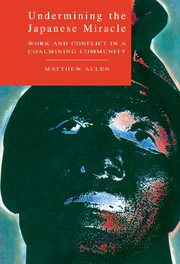Book contents
- Frontmatter
- Contents
- List of Plates
- List of Maps
- List of Figures
- Acknowledgements
- Glossary
- List of abbreviations
- Notes on translation and anonymity
- Map 1
- Map 2
- Introduction
- 1 Chikuho: A Short Description
- 2 The Chikuho Revivalists
- 3 Idegawa
- 4 A Short History of Coalmining: Chikuho in Context
- 5 The Picture Show Man
- 6 A Culture of Violence
- 7 H-san Mine: Violence and Repression
- 8 The Bathing Master
- 9 Labour Conflict: The Case of the K-san Union Action
- 10 D-san and the Students
- 11 Mizuno
- 12 The Y-san Disaster
- 13 Sono
- 14 Welfare
- 15 Welfare in Chikuho
- 16 A Yakuza Story
- Conclusion
- Bibliographical Essay
- Bibliography
- List of Informants
- Index
- Plate section
9 - Labour Conflict: The Case of the K-san Union Action
Published online by Cambridge University Press: 28 October 2009
- Frontmatter
- Contents
- List of Plates
- List of Maps
- List of Figures
- Acknowledgements
- Glossary
- List of abbreviations
- Notes on translation and anonymity
- Map 1
- Map 2
- Introduction
- 1 Chikuho: A Short Description
- 2 The Chikuho Revivalists
- 3 Idegawa
- 4 A Short History of Coalmining: Chikuho in Context
- 5 The Picture Show Man
- 6 A Culture of Violence
- 7 H-san Mine: Violence and Repression
- 8 The Bathing Master
- 9 Labour Conflict: The Case of the K-san Union Action
- 10 D-san and the Students
- 11 Mizuno
- 12 The Y-san Disaster
- 13 Sono
- 14 Welfare
- 15 Welfare in Chikuho
- 16 A Yakuza Story
- Conclusion
- Bibliographical Essay
- Bibliography
- List of Informants
- Index
- Plate section
Summary
The working-class movement in Japan began when the JCP was established in 1922, after Japan had become a military force in East Asia, and following the Russian Revolution. The JCP was perceived as ‘opposition’ to the government, and all communist organisations were outlawed in the years leading up to the Second World War. In such oppressive conditions, union consciousness was poorly developed, and although labour organisations were in evidence in the 1920s, their power was severely compromised by the Police Regulation Law of 1923. This effectively destroyed the unions, based as they were on ‘democratic and socialist’ principles. Although some unions maintained their presence, industry-wide unions were eliminated from the political scenario. The working classes en masse did not unite and confront those people who held power in society, even though there were some conspicuous mass uprisings in the years immediately following the First World War.
The development of union consciousness is directly linked to Japan losing the war. That is, the Occupation, in compliance with its strategy to limit the power of the zaibatsu, sought to increase worker participation in unions. The inalienable right to democracy, the catchcry of the Occupation, underpinned the development of this policy. In actual fact the development of unions in compliance with the laws went ahead, but the running of the new unions was compromised, so that companies controlled the way the movement progressed to a large degree. Wages were controlled and the annual Spring Wage Offensive became little more than a conspicuous social outing, the protests of the Council of Trade Unions (Sohyo) notwithstanding. Industry and government after consultations with employer and union representatives, dictated what sort of pay increases would be awarded.
- Type
- Chapter
- Information
- Undermining the Japanese MiracleWork and Conflict in a Japanese Coal-mining Community, pp. 158 - 180Publisher: Cambridge University PressPrint publication year: 1994



